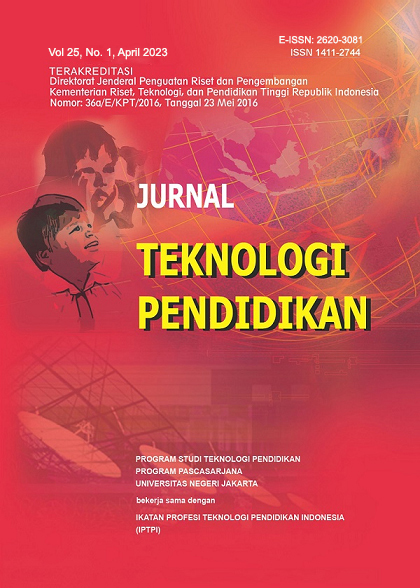The Use of the Arisan Card Method in Economics Learning
DOI:
https://doi.org/10.21009/jtp.v25i1.36779Keywords:
Arisan Cards, Learning Methods, Economic LearningAbstract
Education is a conscious effort to realize something of cultural inheritance from one generation to another. Thus the importance of education in an effort to eradicate ignorance and fight poverty. Through intense economic education in the family environment, one can form economic human beings (homo economicus) who are productive and economical in the use of money and other resources. One of the important subjects in school is economics. The learning method uses the social gathering card. The social gathering card is one of cooperative learning, where students work together in groups to discuss the suitability of the answers to each question that comes out of a glass that has been shaken by the teacher. The type of research used is a quantitative descriptive approach which aims to find out how active students are using the social gathering card method in economics learning. The results of the analysis in this study indicate that there are positive results for the use of the arisan type card method for student learning in economics subjects. The average student learning activity is 79.78 in the "active" criteria. For a teacher must admit and strengthen that what they do is in accordance with the rules and continue to provide motivation so that students are able to develop.
References
Ambarwati, D. (2022). Literature Study: The Role of Educational Innovation in Based Learning. Journal of Educational Technology Innovation , 173-184.
Baihaki, AM (2018). Gathering in Accounting Perspective. Journal of Multiparadigm Accounting, 9(3) , 540-561.
BP, AR (2022). DEFINITION OF EDUCATION, EDUCATIONAL SCIENCE. Al Urwatul Wutsqa: Islamic Education Studies Volume 2, Number 1 .
Handayani, E. (2020). The effect of direct practice methods with game variations on motivation and achievement in learning office technology. Journal of Educational Technology Innovation Volume 7, No. 2, Oct. , 188-195.
Hostess, O. (1992). People Who Count: The Forgotten Faces of the Circulation of Indonesian Savings and Loans Associations. Journal of Anthropology. Vol. 16. Number 4 , 371-441.
Jumri. (2018). EFFORTS TO IMPROVE ECONOMIC LEARNING OUTCOMES WITH . BALANCES Journal of Economic Education, November, Volume 4 Number 1 , (50-57) .
Pristiwanti, D. (2022). Definition of Education. Journal of Education and Counseling VOLUME 4 NUMBER 6 .
Ramadhan, R. (2017). THE INFLUENCE OF SCHOLARSHIPS ON LEARNING MOTIVATION . PROFIT JOURNAL VOLUME 4, NUMBER 2, .
Said, H. (2014). VIRTUAL LEARNING MODEL DEVELOPMENT FOR . EDUCATIONAL LANTERN, VOL. 17 NO. JUNE 1 , 18-33.
Sari, SK (2019). Implementation of the PBL Learning Model with Karsan Media (Arisan Cards) to Improve Learning Outcomes. 1-9.
Sasongko, ND (2016). THE EFFECTIVENESS OF THE INQUIRY METHOD ON THE ACTIVENESS AND LEARNING OUTCOMES OF CHEMISTRY X CLASS STUDENTS. Volume 3, No. 1, April , 40-52.
Shadow, S. (2020). THE INFLUENCE OF EDUCATION, TRAINING AND WORK MOTIVATION ON . Journal of Management Science METHONOMIX .
Thamrin, H. (2021). CSS AND HTML PROGRAMMING TRAINING AT AVICENA VOCATIONAL SCHOOL. ABDIMAS AWANG LONG Vol. 4 No. 1, January , 34-38.
Wati, K. (2015). Phenomenology . Journal of Idea Societa , 2(5), , 1–27., 56-62.
Downloads
Published
How to Cite
Issue
Section
License
Jurnal Teknologi Pendidikan is an Open Access Journal. The authors who publish the manuscript in Jurnal Teknologi Pendidikan agree to the following terms.
Attribution-ShareAlike 4.0 International (CC BY-SA 4.0)
-
Attribution — You must give appropriate credit, provide a link to the license, and indicate if changes were made. You may do so in any reasonable manner, but not in any way that suggests the licensor endorses you or your use.
-
ShareAlike — If you remix, transform, or build upon the material, you must distribute your contributions under the same license as the original.
- No additional restrictions — You may not apply legal terms or technological measures that legally restrict others from doing anything the license permits.
Notices:
- You do not have to comply with the license for elements of the material in the public domain or where your use is permitted by an applicable exception or limitation.
- No warranties are given. The license may not give you all of the permissions necessary for your intended use. For example, other rights such as publicity, privacy, or moral rights may limit how you use the material.








